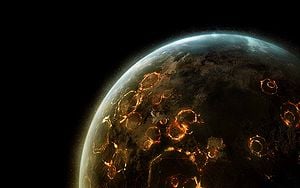Glassing
From Halopedia, the Halo wiki
- "You are...all of you...vermin. Cowering in the dirt thinking... what, I wonder? That you might escape the coming fire? No. Your world will burn until its surface is but glass!"
- — Prophet of Truth
- "Were it not for the Arbiter's counsel, I would have glassed your entire planet!"
- — Rtas 'Vadum


The term Glassing, also known as Plasma Bombardment or Orbital Bombardment, is used to refer to the act by which a Covenant ship or ships, bombard a planet from orbit using their plasma weaponry. The superheated plasma "bolts" discharge, striking the surface and then converts the top soil and other surface geology into a mineral called lechatelierite that is similar to glass, from which the term takes its name. The process also vaporizes any bodies of water the planet may possess, or at least reduces the remaining water to pools choked with ash[1]. The ecosystem of a planet is also disposed off through this process. The Covenant have been known to utilize two methods of glassing, the first and the most common method used is when a ship or ships build up plasma along their lateral lines and discharge lances of plasma from orbit, the lances are guided until they impact the surface. This is repeated until every square centimeter of the planet is destroyed, in most cases it only takes the Covenant 12 hours to glass a planet. The second method is used when a ship must effectively destroy a ground target from low range, this method involves building up plasma from the underside of the ship and then discharging it in a laser beam form, this method of low range glassing has only been witnessed a few times, during the Battle of Pegasi Delta[2] and the glassing of Voi during the Second Battle of Earth. As a result of the destruction the atmosphere of most planets have been known to boil away from the process[3], though not all planets suffer this, the most notable example being Reach.
The impact of the plasma bolt, is similar to that of a nuclear detonation, on a much different scale. When the plasma bolt impacts the surface, the magnetic field sustaining and guiding the plasma collapses, depending on how powerful the release of energy is, the initial zone of impact is obliterated, instantly. The area outside of the initial impact zone are effected by the heat wave generated by the blast; depending on the range, those closest outside of the blast zone are instantly killed by the intense heat. As thermal expansion takes over, the resulting flames fan out and create a pyroclastic surge,[4] the surge will continue to burn the areas it comes into contact with, until it has cooled enough that it cannot harm the surface. Subsequently, the atmosphere is covered with soot and ash, thrown up from the initial impact, subjecting the planet to a nuclear winter. As the initial impact area cools, the surface is covered by extensive areas of molten soil, and is comparable to active volcanic sites in some parts of the world, on a larger scale depending on the extent. The destructive process leaves the planet unable to recover to its former state.
Throughout the Human-Covenant War, the Covenant aggressors glassed a significant majority of the UNSC's colony worlds from orbit. And although ground forces were invariably deployed first, as UNSC forces were routed, the bombardment would commence.[5] The first planet to suffer this fate was Harvest, glassed from the Jiralhanae-operated Cruiser.[6] It has been noted that areas of interest to the Covenant are left intact for reasons of study or retrieval, however this is not common, only three planets have been partially glassed and only when a Forerunner Artifact was discovered.[7] After the Covenant glasses a planet, a shard of glass is removed and placed in the Step of Silence within High Charity, where it hangs with hundreds of other shards from worlds glassed by the Covenant.[8]
The Second Battle of Earth culminated in the glassing of the city of Voi in Africa by Covenant Separatists, in an effort to contain a Flood infestation which had come to Earth only hours earlier. [9] Lord Hood accuses the Sangheili lead fleet of glassing half of the continent, but given his distaste for his former enemies, he might have exaggerated about the actual extent of the glassing. This is supported by the fact that the area around Kilimanjaro seems relatively intact during the ceremony at the end of the game. It is unknown what other areas of the Earth were glassed by the Covenant prior to their abandonment of the planet and the arrival of the Sangheili.
Halo Wars
In Halo Wars glassing appears to be the Covenant's super weapon and the counterpart to the MAC cannon on the UNSC ship Spirit Of Fire. Both are capable of devastating enemy armies and facilities.
Trivia
- By the end of Operation: FIRST STRIKE and Halo 2, the Covenant had glassed 76 planets which were represented by 19 shards in 4 rows in the Step of Silence.[10][11]
- Although the majority of glassing is done by Covenant capital ships, it is possible for a large squadron of Banshees to glass small areas with their Fuel Rod Cannons.
References
- ^ Halowars.com
- ^ Halo:Ghosts of Onyx Prologue Page 25
- ^ Halo: The Fall of Reach, page 8
- ^ Wikipedia's article on Pyroclastic Surge
- ^ Halo: The Fall of Reach
- ^ Halo: Contact Harvest
- ^ Halo: First Strike
- ^ Halo: First Strike Epilogue Page 338
- ^ Halo 3, Floodgate (Level)
- ^ Halo: First Strike, page 338
- ^ Halo 2: High Charity